Guess how many people are on social media globally? Come on, try to guess before your eyes jump to the next line.
4.95 billion social media users, that's 59.4% of the global population (Statista, 2024). So, you've got a viable market on there. But you aren't the only one who has this information. Every brand out there has access to the data.
This is why you need a well thought-out social media marketing plan comes. In this article, I’ll walk you through the steps you need to build such a plan, complete with how to find and engage with your audience, craft compelling content that resonates with them, and ultimately measure success.
What is Social Media Marketing?
Social media marketing is the use of social media platforms to connect with your target audience. It involves the strategic creation, sharing, and management of social content, community building, and leveraging social media advertising to achieve specific marketing and business goals.
Social media platforms provide a direct channel for brands to engage with consumers more authentically, which helps to build brand loyalty and drive sales. Specifically, 82% of consumers prefer to buy from brands whose values align with their own.
Nowadays, many social platforms are also being used as direct sales channels. According to 80% of social media marketers, consumers make purchases directly through social platforms more often than through a brand’s website. The challenge lies in doing social media marketing the right way.
How to Create a Social Media Marketing Plan
Let's get into how you can create a winning social media marketing plan.
Step 1: Define Your Social Media KPIs
The first step in creating an effective social media marketing plan is to know where you’re headed. That’s why your plan should include your social media KPIs, which are linked to your marketing and business objectives.
So ask yourself: What are you trying to achieve through your social media marketing efforts? Do you plan to run social selling programs or are you looking to drive brand awareness?
Your marketing funnel is a great way to answer this question. How can social media help you reach your audience in every part of the funnel?

For example, in the awareness stage, you'll want to focus on generating brand awareness and brand-building activities. In social media terms, this translates into growing your number of followers and likes and expanding your reach.
Meanwhile, in the conversion stage of the funnel, your aim will be to drive sales. So you'll want to focus on actions that drive your audience to visit your website or purchase directly through the social media platform.
The table below summarizes what your social media goals can look like in every part of the marketing funnel and the metrics you can keep track of to measure those goals.
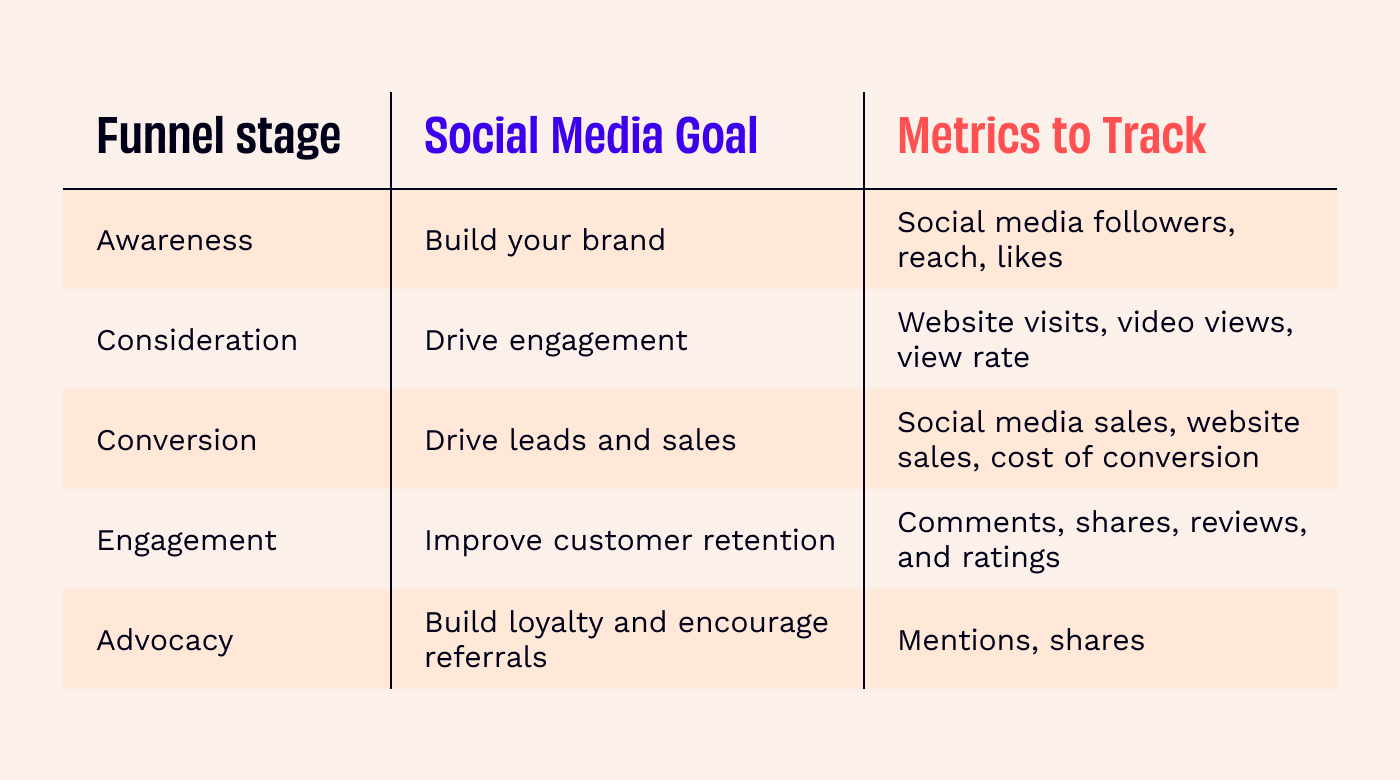
Now that you know what you want to achieve, it’s time to be specific with your metrics. Setting SMART goals can help you with that. SMART goals are a framework for setting well-defined and actionable objectives that are Specific, Measurable, Achievable, Relevant, and Time-bound.
Here are some examples of what SMART goals in social media marketing can look like:
- Awareness stage: Increase brand awareness via Instagram marketing by growing the follower count by 20% over the next three months.
- Consideration: Drive website traffic by increasing click-through rates from social media posts by 15% within two months.
- Conversion: Generate 100 leads through social media campaigns in the next quarter by optimizing landing pages and running targeted ad campaigns.
- Engagement: Increase customer engagement by 15% on Facebook by implementing a content strategy that encourages user-generated content and promotes interactive discussions.
- Advocacy: Increase social media shares of brand-related content by 30% within four months, encouraging customers to advocate for the brand.
These SMART social media marketing goals can look very different for your business, depending on the slant of your social media marketing strategy. When setting SMART goals, it's crucial to ensure they align with your business objectives, are within your capabilities, and can be effectively tracked and measured.
Step 2: Do Your Research
Before starting to think of plans and tactics to help you achieve your social media objectives, you should do your research. You can do this manually, or you can also use social media analytics tools to help you. Here’s a list of the best social media analytics software to get you going.
Brand24 and Agorapulse are some of the best I've come across for social research.
Conduct an audit
Conducting a social media audit helps you gain insights into your current social media presence, assess the effectiveness of your existing strategies, and identify areas for improvement.
Simply put, this step will help you identify what is working, what’s not, and where you need to focus your attention next.
Here's a step-by-step, simple guide on how to conduct a social media audit:
- Identify your social media platforms: Make a list of all the social media platforms where your business has a presence. Evaluate the completeness and consistency of your profile information across platforms. Check that your profile pictures, cover images, bios, contact details, and website links are current and aligned with your brand identity.
- Assess follower and engagement metrics: Analyze your follower count, reach, impressions, and engagement metrics (likes, comments, shares, retweets) on each platform. Look for patterns or discrepancies in engagement levels and identify which types of content have been most successful in driving engagement.
- Do a content analysis: Review your past social media posts and assess their performance. Look at the content types (articles, videos, images), formats, themes, and messaging used. Identify the posts that received the most engagement and those that underperformed.
- Assess advertising campaigns: If you've run social media advertising campaigns, evaluate their performance. Look at the objectives, targeting, ad creative, and the results achieved (click-through rates, conversions, ROI). Determine which campaigns were successful and which underperformed.
- Conduct a social listening analysis: Monitor social media platforms for mentions of your brand, products, or services. Assess the sentiment, tone, and feedback from customers. Identify any reputation management issues that need to be addressed or opportunities for social media engagement. You can also rely on social listening tools to complete this step.
You can use a spreadsheet to keep track of and organize the information. Next, compile your findings from the audit and create a summary report. Identify trends, strengths, weaknesses, opportunities, and areas for improvement.
Research your competitors
Next, it’s time to evaluate the social media presence and activities of your main competitors. Here you can follow the same steps you did to audit your own social media presence.
Review the channels your competitors are active on, their follower count, what type of content they post, and how their followers engage with their content. You can also analyze customer feedback, complaints, or praise to understand how your competitors are perceived by their audience.
And remember, the goal of the competitor analysis isn't to copy your competitors, but to gain insights and find unique ways to position your brand and engage with your target audience effectively.
Research your audience
Use social media analytics and insights to understand your audience's demographics, interests, and behavior. Identify who your most engaged followers are and what content resonates with them.
Answer the following questions:
- Is your existing strategy helping you reach the desired audience?
- Are there audience groups you’re not serving with your content?
Refer to your buyer persona(s) to answer them. If you don’t have buyer personas, now is a good opportunity to create them. By recognizing that not all customers are the same, you can develop more effective marketing campaigns. Marketing segmentation tools can help you with the process of building personas.
Step 3: Choose Your Platforms
The next step is deciding through which channels you are going to reach your audience.
Overview of popular social media platforms
These are the most popular social media networks. You'll need to consider where your audience spends time on social media. But these statistics can help you make a business case for any platform you end up going with as your primary social channel.
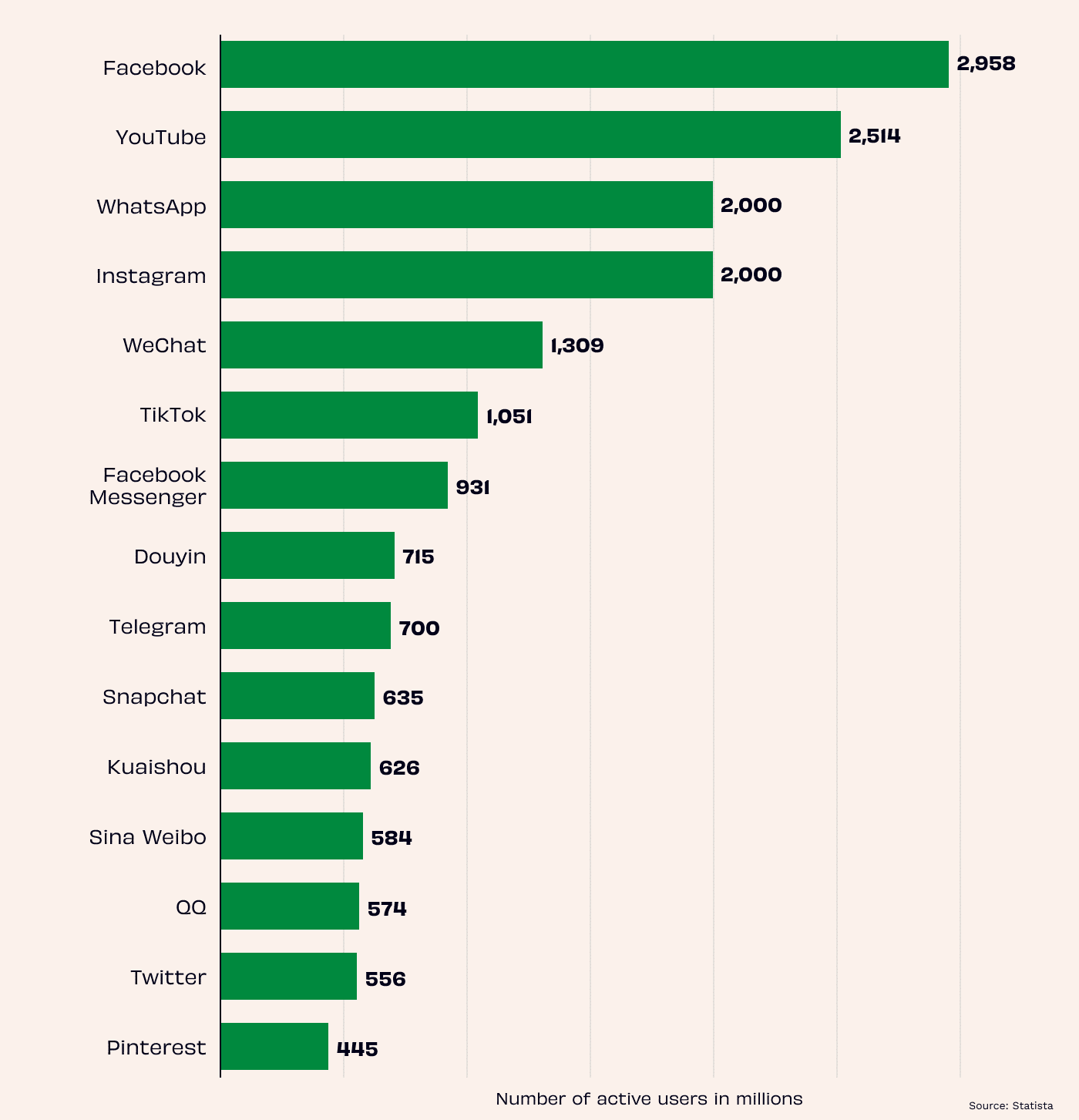
And these are the social media channels that deliver the best ROI.
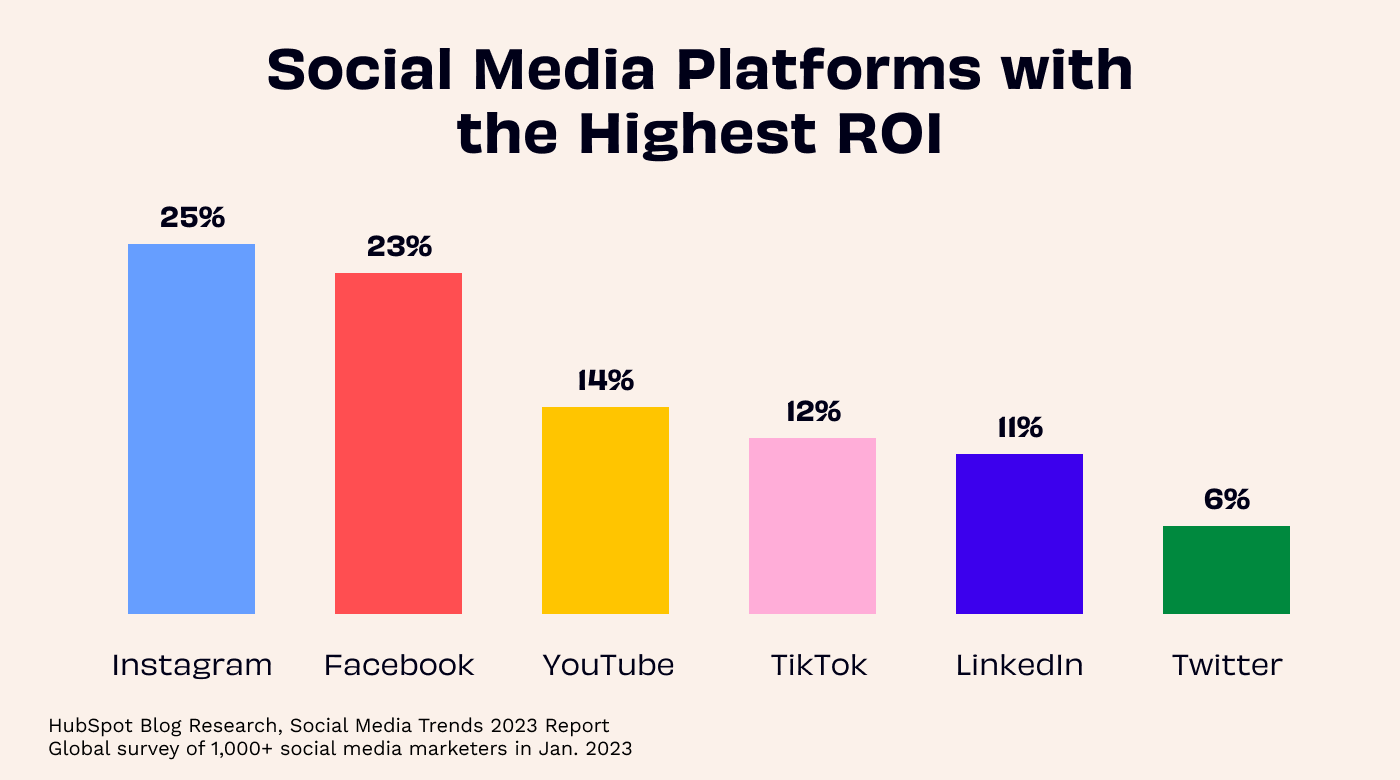
You can refer to the table below for a breakdown of the demographics and user behavior of some of the most popular social media platforms.
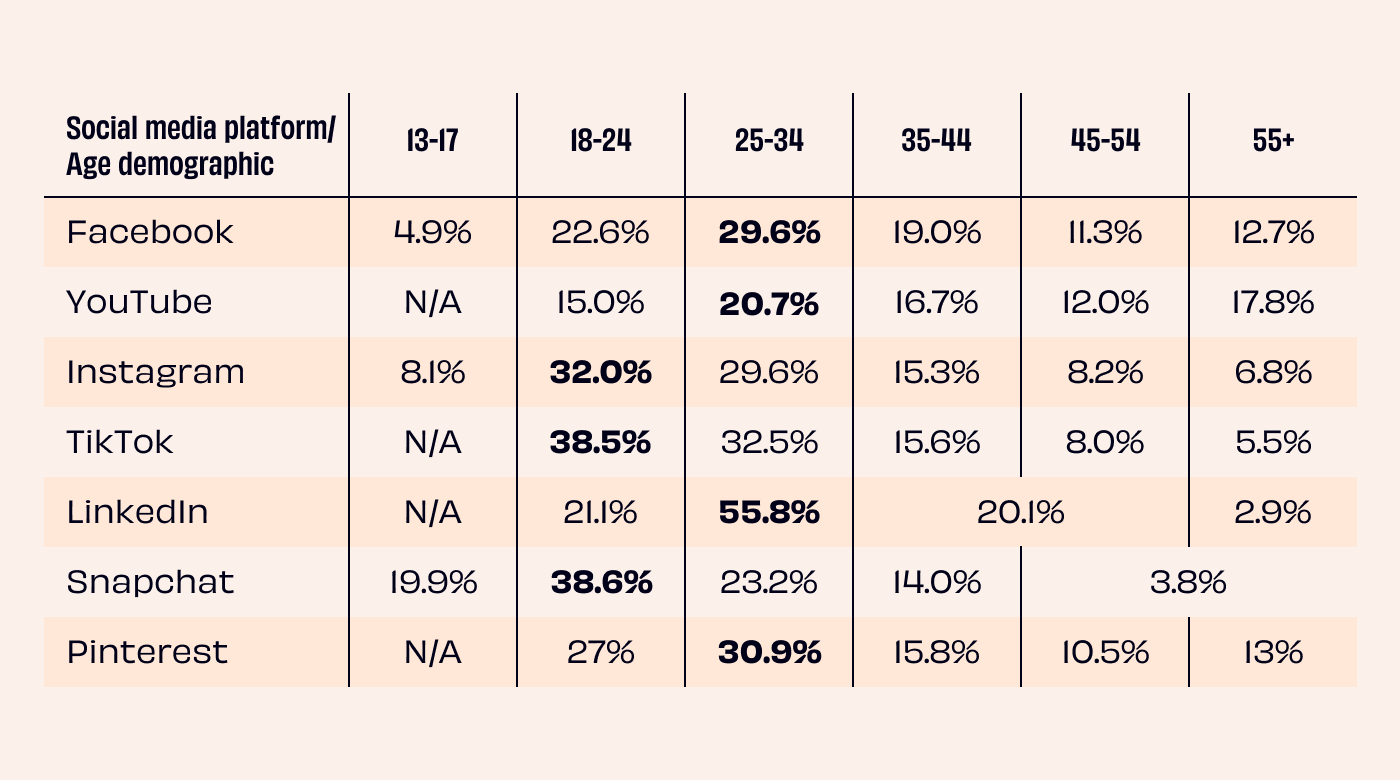
It’s also worth noting that the demographic split by gender is nearly equal between all platforms, with one exception — Pinterest. Pinterest’s users are predominantly female.
Select the most suitable platforms for your audience
Refer to your previous research — which channels are driving results for your business, and which aren't? Which channels are driving results for your competitors? And which channels is your audience using? That'll help you decide to:
- Continue investing your time and effort in the channels that are delivering the best ROI.
- Focus more on channels that are underperforming but have potential.
- Stop wasting your time and effort on channels that aren't performing well and have little potential.
- Determine the estimated social media management costs (time commitment as well as money)
- Decide if and which new channels to start using.
Here you should also consider your broader business and marketing objectives. Let’s say your business is planning to launch a new product catering to a younger audience. Then it could be a good idea to leverage TikTok or Snapchat to reach this new demographic.
Don’t try to be everywhere at once, though. Each social channel has its own approach and strategy you have to follow. So while you can definitely repurpose content (e.g., shoot content for Instagram reels which you can also use on TikTok and YouTube shorts), you’ll also need to keep up with trends and engage with your audience across channels. So prioritize by taking stock of your resources and how you can best use them.
Pro tip: you can track all campaigns across all platforms using marketing planning software, which can also help you visualize cost/benefit analysis for each channel.
Optimize your social media profiles
Here are some tips to help you optimize your social media profiles:
- Use the same username across platforms.
- Use the same profile picture, cover photo, and bio to create a recognizable and cohesive brand image.
- Incorporate relevant keywords in your bio, headline, and descriptions to help people find your profile when searching for specific topics or interests.
- Maintain a consistent tone and voice in your posts and interactions.
Step 4: Decide What Type of Content You’ll Create
Next, it’s time to decide how you're going to engage with your audience. What type of content should you post?
The image below shows which content types are most effective on social media in 2023.
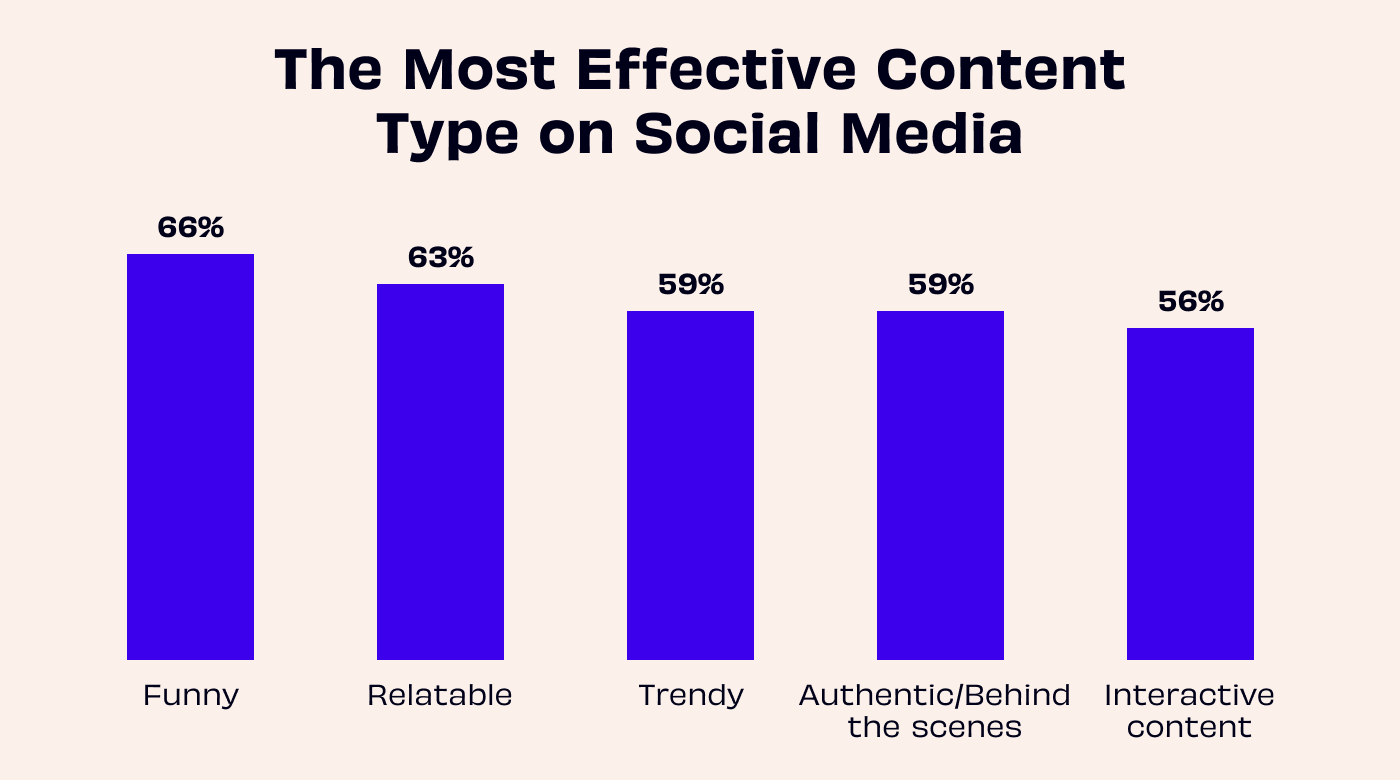
People go on social media to unwind and relax, so funny and relatable content are two of the most effective content types.
Of course, your content should always be in line with your brand and geared toward your products or services. One of the most effective social media ads of all time demonstrates well how you can achieve this balance. Introducing: the famous Dollar Shave Club product launch YouTube ad.
Authentic and behind-the-scenes content can also be highly effective. And, of course, you should keep an eye on social media trends. For instance, to appeal to consumers in 2023, you can leverage short-form video, meme marketing, and technology like augmented reality to provide interactive content.
Nevertheless, your social media content management plan should define your content formats and types.. Every piece of content you push out there should be linked to your objectives and be in line with your marketing funnel. Below, I’ll show you a few examples of what that looks like.
Driving product awareness
During the awareness stage, your goal is to introduce your brand to a wider audience. This isn't the time for a hard pitch, so avoid overly promotional content. Instead, focus on optimizing your posts for social search and creating educational content that relates to your customer’s pain points and interests.
For example, coffee brand Nespresso uses TikTok to share tutorials that you can essentially prepare with different brands of coffee. This way, they not only demonstrate how to use their products, but they focus on teaching their audience how to prepare drinks.
@nespresso There's nothing like coffee and chocolat ☕️ @Chantal Lilly #nespresso #nespressovertuo #vertuopop #coffeemoment ♬ original sound - Nespresso
Encouraging product consideration
In the consideration stage, you want to reach people who are already familiar with your brand by educating them more about your products. You can do so by sharing posts that show your products or services in action.
Beauty brand Huda Beauty is well known for leveraging influencer content to achieve this. Here’s an Instagram post example that shows it.
This type of content helps to build trust and confidence in your products and brand.
Driving conversions
In the conversion stage, your audience needs a little nudge to take action. So think about creating promotional posts featuring discounts or offers. You can also leverage paid social media ads to amplify your message.
Here’s how fashion brand Baggu is using paid Facebook ads to promote its products - highlighting its free shipping and returns to encourage its audience to take action.

Baggu uses paid Facebook ads to promote its products.
Encouraging customer engagement
During the engagement phase, your primary goal is to foster a connection with your audience and build brand loyalty. To achieve this, you can create social media content that focuses on storytelling, interacting with your audience, and inviting them to be part of the conversation.
Encourage your followers to create content related to your brand or products. User-generated content (UGC) can include testimonials, reviews, photos, and videos featuring your products or services.
The fashion company Aerie encourages its customers to share content through its branded hashtag: #aeriereal.

Driving customer advocacy
During the advocacy stage of the marketing funnel, your focus should be on leveraging your existing customers to promote your products or services to a wider audience. A well-thought out social media community management plan is key to making this work.
Encourage your existing customers to refer their friends, family, or colleagues to your business. Organize contests or giveaways exclusively for your existing customers or followers. Encourage them to participate by sharing their experiences, creating user-generated content, or spreading the word about your brand. Offer attractive prizes or exclusive rewards to incentivize participation.
ColourPop Cosmetics is well-known for its giveaway contests.
Step 5: Build Your Social Media Calendar
A social media calendar is a marketing tool that helps you plan, organize, schedule, and manage your social media content and initiatives.
You can build your social media calendar using a Google spreadsheet, like the one shared by Semrush.
How often should you post on social media?
This is one of the questions you’ll have to answer when creating your social media calendar. There's no one-size-fits-all answer, but here are some general guidelines for how often you should post on different social media platforms:
Look at the shelf life of content on each platform
On platforms like Twitter and Pinterest, which have a fast-paced nature, you should post more often, such as several times per day. Meanwhile, you should post on Instagram and Facebook feeds once a day or 3-4 times per week. Facebook and IG stories, on the other hand, are only visible for 24 hours, so you should post and share content several times per day. YouTube videos have a longer shelf life and require more effort to create, so scheduling a new video once per week should be fine.
Take your resources into account
When it comes to social media, it is ultimately important to maintain consistency. So don’t go overboard, jam-packing your calendar with more content and campaigns than you can afford. Quality content that resonates with your audience is more important than overwhelming them with too many posts.
When should you post?
According to Hootsuite, the best time to post on social media is mainly on Mondays at around 9 AM PST. The image below shows the best time for each network.
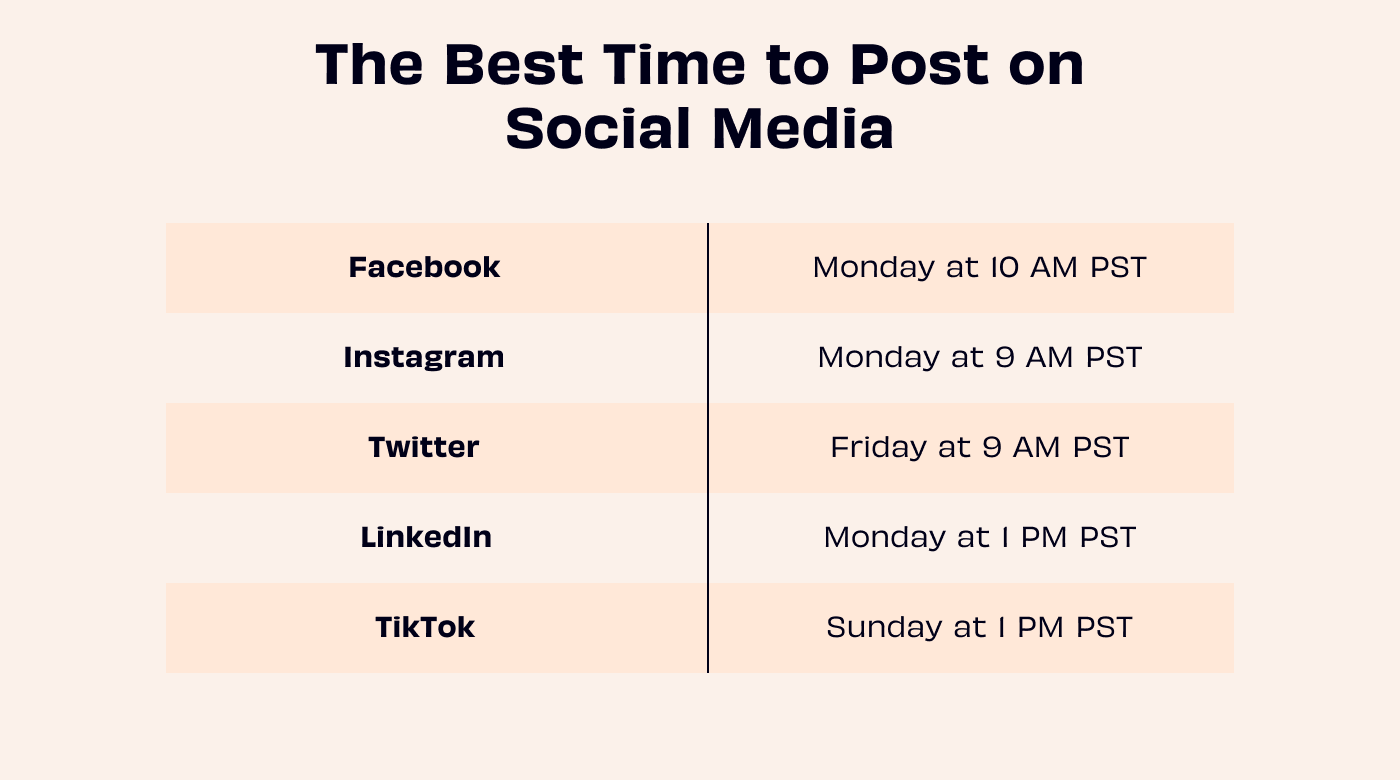
This isn't an exact science. The truth is there’s no magic time that'll make your performance skyrocket.
You’ll have to see which time your audience is most active by looking at the performance of your posts and social media analytics.
Step 6: Track Your Performance and Adjust Accordingly
Keep track of the KPIs you've agreed on with your marketing leadership. Track what’s working and what’s not in your social media report document.
If you notice that certain posts receive higher engagement than others, try to understand what makes them successful and apply those insights to future content. This is an ongoing process that requires constant monitoring and adjustment as you go.
Examples of Social Media Marketing Plans
A social media marketing plan is a map that shows your goals, how you’re going to measure them, and how you're going to achieve them. And goes a long way with helping with your approach to social media management.
I've often used PowerPoint or Excel for my social plans. It’s important that the plan is sharable with the team and allows you to organize and track the progress of your efforts.
Using a Social Media Marketing Plan Template
A social media marketing plan template can help you build an overview of your plan. For example, you can use Excel to build a template that enables you to see at a glance your objectives and the channels and strategies you’re going to implement to achieve them.
Besides the master plan overview, there are a number of marketing templates that make up your social media marketing plan, including research templates, content calendars, and analytics reports.
The templates help you organize the information and ensure you don’t leave out anything important. To truly make the most of templates, you should adjust them to include the information that's important to you.
Best Practices for a Winning Social Media Marketing Plan
With billions of active users across various platforms, social media offers unparalleled opportunities to reach and engage with your target market. However, to harness its full potential, you should follow some best practices that drive results and foster meaningful connections.
Be Authentic
Yes, I’m aware this may sound a bit cliche. But it’s true, and it’s worth remembering. Brands like Duolingo and Ryanair have built a huge social media following by humanizing their brands.
Ryanair has over 2.1 million followers on TikTok, where it posts sassy, funny videos the audience loves to watch. They have a deep understanding of who their customers are and what they care about. So the airline embraces a bold, young, and fun personality.
They use the same tone of voice when replying to comments as well — which people also love. Just look at the number of likes on the company’s comments.
Don’t Ignore Social Media Ads
While social media is great for brand and community building, it can also be used as a direct sales channel. So don’t ignore the power of social media ads. Even if you’re just getting started, ads can help get you in front of your intended audience.
Balance Planning and Flexibility
Remember that all these are general guidelines, and you should always monitor your audience's response and engagement metrics to fine-tune your planning. So learn to listen to audience feedback and adapt on the go.
Moreover, leave space in your plan for creating content that corresponds to trends and real-life events.
Social Media Marketing Plan vs. Social Media Marketing Strategy
The terms "social media marketing plan" and "social media marketing strategy" are often used interchangeably, but they mean different things.
A social media marketing plan is a tactical document that outlines the specific actions, tactics, and implementation details for achieving social media marketing goals. It focuses on the execution and operational aspects of social media marketing.
A social media strategy, on the other hand, is a broader and more comprehensive approach that encompasses the overall vision and direction of your social media marketing efforts.
The social media marketing plan serves as a roadmap on how to achieve the goals and objectives laid out in your social strategy. The plan deals with the practical side of social media marketing — which is what I’ll focus on in this article.
Action Your Social Media Marketing Plan
A social media marketing plan is your roadmap to building strong customer relationships and achieving your business objectives. In this article, we walked through the steps you need to take to build an effective plan. Now it’s time to put that plan into action.
Remember that a social media marketing plan isn't a static document stored in a digital folder. It’s a living, breathing roadmap that requires consistent monitoring and adaptation. So stay attuned to trends, shifts in consumer behavior, and emerging platforms.
Enjoyed this piece? Then you should sign up to our newsletter for marketing leaders for more of the good stuff. Join us.




